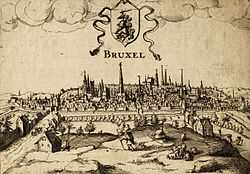City of Brussels
| City of Brussels Ville de Bruxelles Stad Brussel | |||
|---|---|---|---|
| Municipality | |||
 | |||
| |||
 City of Brussels Location in Belgium | |||
|
City of Brussels in the Brussels-Capital Region  | |||
| Coordinates: 50°51′N 04°21′E / 50.850°N 4.350°ECoordinates: 50°51′N 04°21′E / 50.850°N 4.350°E | |||
| Country | Belgium | ||
| Community |
Flemish Community French Community | ||
| Region | Brussels | ||
| Arrondissement | Brussels | ||
| Government | |||
| • Mayor (list) | Yvan Mayeur (PS) | ||
| Area | |||
| • Total | 32.61 km2 (12.59 sq mi) | ||
| Population (1 January 2013)[1] | |||
| • Total | 166,497 | ||
| • Density | 5,100/km2 (13,000/sq mi) | ||
| Postal codes | 1000-1130 | ||
| Area codes | 02 | ||
| Website | www.brussels.be | ||
The City of Brussels (French: Ville de Bruxelles [vil də bʁysɛl] or alternatively Bruxelles-Ville [bʁysɛl vil], Dutch: Stad Brussel [stɑd ˈbrʏsəl][2] or Brussel-Stad) is the largest municipality of the Brussels-Capital Region, and the de jure capital of Belgium,[3] though the Brussels Capital Region as a whole acts as the capital of Belgium. The City of Brussels comprises primarily only the historic centre of Brussels and may be compared to the City of London in the Greater London Authority.
The City of Brussels is a municipality consisting of the central historic town and certain additional areas within the greater Brussels-Capital Region, namely Haren, Laeken and Neder-Over-Heembeek to the north, and Avenue Louise and the Bois de la Cambre park to the south.
On 1 December 2014, the City of Brussels had a total population of 178,165. The total area is 32.61 km² which gives a population density of 5,464 inhabitants per km². As of 2007, there were approximately 50,000 registered non-Belgians in the City of Brussels.[4]
Territorial history

At first, the City of Brussels was simply defined, being the area within the second walls of Brussels, the modern-day small ring. As the city grew, the surrounding villages grew as well, eventually growing into a contiguous city, though the local governments retained control of their respective areas.
The construction of Avenue Louise was commissioned in 1847 as a monumental avenue bordered by chestnut trees that would allow easy access to the popular recreational area of the Bois de la Cambre. However, fierce resistance to the project was put up by the town of Ixelles (which was then still separate from Brussels) through whose land the avenue was supposed to run. After years of fruitless negotiations, Brussels finally annexed the narrow band of land needed for the avenue plus the Bois de la Cambre itself in 1864. That decision accounts for the unusual southeastern protrusion of the City of Brussels and for Ixelles being split in two separate parts. The Université Libre de Bruxelles' Solbosch campus is also part of the City of Brussels, partially accounting for the bulge in the southeast end.
Unlike most of the municipalities in Belgium, the ones located in the Brussels-Capital Region were not merged with others during mergers occurring in 1964, 1970, and 1975.[5] However, several municipalities been merged with the City of Brussels throughout its history including Laeken, Haren, and Neder-Over-Heembeek, which were merged into the City of Brussels in 1921.[6] These comprise the northern bulge in the municipality.
Mayors
As in every other Belgian municipality, the City of Brussels is headed by a mayor, which should be confused with neither the Minister-President of the Brussels-Capital Region nor the Governor of Brussels-Capital.
Capital of Belgium
According to the Belgian Constitution (Art. 194) the capital of Belgium is the City of Brussels municipality. Arguments that the use of lower case in "ville" and "stad" in Article 194 for "ville de Bruxelles" (French), "stad Brussel" (Dutch) makes a subtle difference and means that Brussels at large as the capital cannot be defended on a legal basis. However, although the City of Brussels is the official capital, the funds delegated by the federation and region for the representative role of the capital are divided among the 19 municipalities and, in practice, national Belgian institutions are indeed located not only in the City of Brussels, although many are, but also in most of the other 18 municipalities of the Brussels-Capital region. The implication is that de facto the entire Region serves as capital, but de jure only the City of Brussels is entitled to the title of capital of Belgium.
See also
References
- ↑ Population per municipality on 1 January 2013 (XLS; 607.5 KB)
- ↑ Stad in isolation: [stɑt].
- ↑ Article 194 of Belgium's constitution
- ↑ Statistics foreign population in Belgium by municipality (in French and Dutch only)
- ↑ Picavet, Georges (29 April 2003). "Municipalities (1795-now)". Georges Picavet. Retrieved 2009-04-05.
- ↑ "Brussels Capital-Region". Georges Picavet. 4 June 2005. Retrieved 2009-04-05.
External links
| Wikimedia Commons has media related to City of Brussels. |
- Official website of The City of Brussels
- Page related to The City of Brussels in the Brussels-Capital Region official web site
- Webcam Grand-Place Brussels
- Interactive map of Brussels historical city centre
| |||||||||||||||||||||||||||||||||||||||



